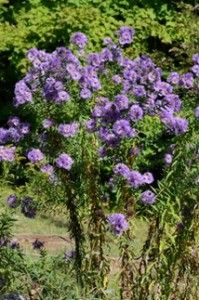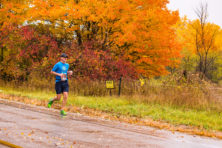The Colors of October
- Share
- Tweet
- Pin
- Share
“There is something in October sets the gypsy blood astir…The scarlet of the maples can shake me like a cry of bugles going by.” So wrote William Bliss Carman in his “A Vagabond Song.” Surely these words fit many of you (and me!) to a “T.”
Every year at this time I come down with a bad case of “gypsy feet” and am happiest when marveling at the daily changes of color that adorn the landscape in all directions, tramping the fields, bottomlands and shores, or exploring the lovely sun-drenched stone fences.
Frosts, its presence or absence, pays no part in the coloring of leaves, in spite of many people believing just the opposite. Brilliant sunshine will help to convert leaf starches into sugars, bringing out the best deep purples the ashes can produce, and the Sugar Maples will show their most blazing red and oranges from miles away. Day after day of cloudy overcast skies in autumn result in rather dull subdued leaf color.

Even a young Northern Red Oak can have brilliant fall color.
I am still holding to my prediction, made this past early summer that the fall color this year will be somewhat later than usual due to the cold and lingering spring weather that resulted in the trees leafing out very late.
It is generally believed that many hardwood trees are programmed by nature to retain their leaves a specific number of days, and this is the reasoning upon which I base my prediction.
I have enjoyed the peaceful, gentle outdoor concerts of mild October nights ever since I was a child. The internationally known performers, among the world’s most ancient instrumentalists, are known to sing with their wings and hear with their shinbones. Furthermore these inch-long fiddlers, the black Field Crickets, are right-handed! At least they’re right-winged.
When the male Field Crickets fiddle they are said to stridulate. These well-known sounds are produced entirely by wing vibrations. When the wings are elevated slightly and stiffened, the scraper on the underside of the right wing is rubbed rapidly over the file on the upper surface of the left wing and, voila, music! Recordings of Field Crickets’ songs, played at reduced speeds, reveal rather sophisticated hidden qualities. By the way, their singing temperature range is between 55 and 100 degrees F.
Become a phenologist. Write down your daily observations in nature and file them, for example, by month. Make record of the spring leafing out of the trees followed by their peak of fall color in autumn. Your comparisons from year to year will be proof positive!
My journal entry of Oct. 6, 1995, roughly 19 years ago, told of the Basswood trees in our front yard having lost 90 percent of their leaves already and that Shaggy Mane mushrooms were popping up all over the yard. By the 9th the Fox Sparrows had arrived and had joined a dozen or more White-throated Sparrows and a smaller number of Dark-eyed Juncos at the cracked corn on the driveway. Yellow-rumped Warblers were seen in our woods on the 18th and a Monarch Butterfly was observed heading south along Highway A. Tree Sparrows joined the other bird species in our front yard by the following day.

New England Asters can be found along many roadsides in northeast Wisconsin.
By 7:30 am on the 21st huge “chicken feather” snowflakes were coming down. Fortunately the “white stuff” melted quickly. The brilliant orange-flowered Mexican Sunflowers (Tithonia) continued to be in excellent blossom in our butterfly garden and the birches and oaks still are clinging tightly to their leaves.
There was “frost on the pumpkin” the morning of the 23rd as we watched more than a dozen Eastern Bluebirds feeding along the road bordering our land. Queen Anne’s Lace, Sow Thistle and several species of asters were still in surprisingly good bloom. Ice covered our bird baths on the morning of the 25th and by the following day the first Evening Grosbeaks were reported from Baileys Harbor and Fish Creek.
The Witch Hazel, last blossoming shrub, was still in fairly good flower. Go in search of these beautiful plants but, should you bring a bouquet of them into your home, be aware of their “exploding” seed capsules (the light field artillery!) which still harbor last year’s seed crop. Don’t be surprised during the middle of the night by the ricocheting of the seeds as they are shot from the “cannons!”
Be satisfied with the spiritual message of the lovely fall asters rather than struggling to identify this large and difficult group. Because we find them everywhere these October days, we somehow forget them. Oh, the tragedy of the commonplace! It seems as though many Americans need journeys to far-away lands to see things “worth beholding,” when practically every Wisconsin roadside is now ablaze with color. If any species of the delightful aster tribe appears to be more showy than the rest it has to be the rather tall New England Aster, fairly common in Door County but surpassingly uncommon in New England, as the experts tell us.
As much as the weather experts ridicule forecasts of the winter-to-come based upon the Woolly Bear caterpillars, one can nevertheless have fun doing so. These are the caterpillars that are black on each end and have a rusty-brown band in the middle. The old-fashioned belief was that if the brown bands are wide, then the coming winter will be mild and if they are narrow, the winter will be nasty. Here again you have to keep up with your phenological records, which will enable you to compare one winter, along with the Woolly Bear caterpillars, with the next – year after year.
One observer of people concluded that only the slow pokey hikers, the lazy loiterers really see, for they alone see who see with their minds. They pause at interesting items along the trail, think about them and make mental notes before continuing the outing.
I hope you will be able to thoroughly enjoy this October at a delightfully slow pace – outdoors!



